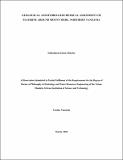| dc.description.abstract | Areas around Mt. Meru are among the areas in Tanzania where climate change, population
growth and high fluoride levels in much of the water sources lower availability of water for
domestic and agricultural uses. Therefore, a study was conducted to review Holocene
climatic records in relation to fluoride variation, assess fluorine source rocks and minerals, its
dispersion patterns and hydrological characteristics of the aquifers in relation to the quality of
water around Mt. Meru. Holocene climatic records indicated high concentration of fluoride in
glacier at Mt. Kilimanjaro during dry phases (eg. 8.2 and 4.0 ka) and early Holocene, most
likely derived from dried shallow lakes. High fluorine concentrations were obtained in rocks
(mean= 0.39%, n=68) and soils (mean= 0.35%, n=32) with maximum values of 1.91% and
1.78% respectively. F was high in andesitic rocks (mean= 0.71%, n= 13) relative to other
weakly fractionated rocks suggesting incompatibility of F in early stages of fractional
crystallization. It was also high, about 3 folds in rocks relative to equivalent soils. The main
contributing minerals in the order of decreasing are sphene, hornblende, apatite and biotite.
Rock-equivalent soils relationship indicated that rock texture is the main factor controlling
the release of fluorine from rocks to soils with more ions dissolved in groundwater in areas
dominated by the relatively soluble materials (lahars). Mobility of fluorine in soils and water
was found to be largely controlled by soil type, soil chemistry and groundwater movement.
The dominant water type was found to be Na-K-HCO
3
with high Na
+
and K
being largely
released from nepheline and clinopyroxene minerals. Overall, excluding highest fluoride
values in leeward lakes (mean=567 mg/l, n=3), fluoride was also high in other water sources
(mean=10 mg/l, n=97). Lowest values were in windward springs (mean=1.3 mg/l, n=21).
The quality of water for domestic and agriculture uses was moderate in the order of springs >
streams > boreholes > dug wells > lakes. Resistivity survey revealed freshwater aquifers
characterized by the resistivity between 35 and 60 Ωm hosted in weathered mafic volcanic
rocks, tuffs and breccias and aquifers of low groundwater quality exhibiting resistivity
between 15 and 25 Ωm hosted in lahars. It is further revealed that there is a strong negative
correlation between aquifer resistivity with both Electrical Conductivity and fluoride in the
corresponding groundwater. Groundwater Potential Index Map which serves as a guide for
further groundwater development has been developed using integrated data. It is
recommended to conduct leaching experiments and microprobe analysis for fluoride bearing
minerals, assessing mobility of fluoride from soil to plants, levels in plants and livestock,
protection and conservation of water sources.
+ | en_US |


